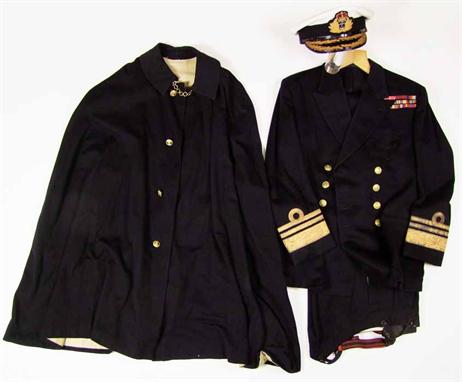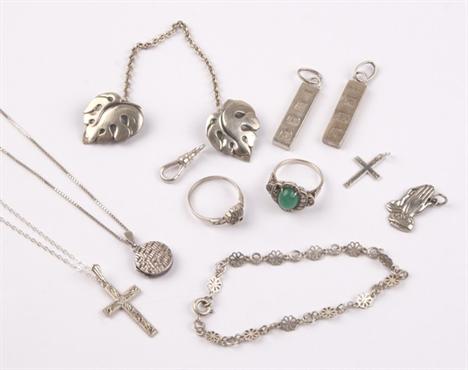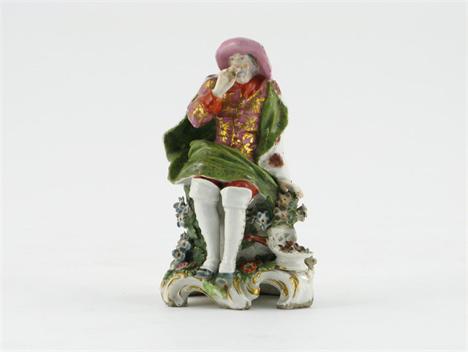A Fine 15th Century Limewood Carving of Saint Michael with traces of original polychrome. Saint Michael depicted with curly hair once holding a spear (now missing) in one hand, with a shield by his side, wearing a long red cloak over a full length tunic with demon trampled underfoot, 36 ins (92 cms) in height.* ]
We found 7207 price guide item(s) matching your search
There are 7207 lots that match your search criteria. Subscribe now to get instant access to the full price guide service.
Click here to subscribe- List
- Grid
-
7207 item(s)/page
A Splendid & Rare Set of Four 15th Century Gothic Oak Beam Supports. Each support carved with the figure of a saint stood beneath an arcaded canopy above a shield below: St Anne with Mary and the infant Christ, St. George slaying the dragon, St. Barbara holding a castle and St. James wearing a cloak. Approximately 36 ins (90 cms) in height, 8 ins (20 cms) in width.* ]
Three Unusual Elizabethan Three-quarter Length Figures carved from dark, richly patinated pine. Two carved in the form of bearded men wearing cloaks over doublets & full breeches; their hair curled around their heads and fashioned into small quiffs at the front, 18½ ins & 18 ins (47 cms and 46 cms) in height. The third wearing a head-dress and cloak over a tunic with rope tied around the waist, 17 ins (43 cms) in height.* ]
A pair of continental figurines possibly Sitzendorf of a young woman with a basket of flowers and her male companion holding a musical instrument and another similar figurine of a young man in a scarlet cloak also holding a musical instrument (3) - all standing on rococo gilt and floral encrusted bases
Various silver items, comprising small circular locket & chain, ornately patterned cross pendant & chain, ingot pendants (2), small cross pendant, praying hands pendant, fancy link bracelet, swivel fastener, ladies` marcasite set ring, ladies` green agate & marcasite set ring, small marcasite missing & a set of cloak clips with chain, stamped, tested or h/m (1.55oz) (11)
Andrew McIlwraith (fl.1715-1753) PORTRAIT OF JAMES KER OF BUGHTRIG (1700-1768), HALF LENGTH, in a blue coat, white stock and fur-trimmed cloak, Signed `And:McIlwraith Pinxt` and dated 1754 verso, also inscribed `Ja:Ker Esq Conveener/ Member of Parliament for Edinburgh / 1754`, oil on canvas, painted oval , 77 x 63.5cm. The portrait is most probably a contemporary copy of a picture by Allan Ramsey in the National Gallery of Scotland.James Ker was without doubt one of the most talented and important goldsmiths in 18th Century Edinburgh, and dominated the craft both technically and politically throughout the middle years of the century. He was the only craftsman in the 18th Century to represent Edinburgh at Westminster - remarkable for a task reserved for members of the city`s merchant elite. Ker, was son of Thomas Ker, the Edinburgh goldsmith, born to him and his wife Margaret on 14th September 1700. The family was related to the aristocratic house of Ker, Marquesses of Lothian, and shows another example of younger sons of gentry going into the socially acceptable trade of the goldsmith. James was apprenticed to his father at the age of 8 on 12th July 1709, the same year his father was elected deacon of the Incorporation. He undoubtedly prospered, as many items survive of his craft. In 1736, he bought the estate of Bughtrigg near Jedburgh in the borders for £1500. He married, firstly, Jane Thompson in 1725, who died in 1746, and subsequently Elizabeth, daughter of Lord Charles Kerr of Cramond, brother of the 2nd Marquis of Lothian. See previous lot. He was prominent in the affairs of the Incorporation and the city, serving as deacon and town councillor on numerous occasions. Politically he was a Whig. In the chaos of the 1745 Jacobite Rebellion, the members of the Town Council, who elected the city`s single Westminster member of parliament, chose Ker as their MP. His hold on office could not last and, at the elections of 1754, the Edinburgh merchants closed ranks and he was defeated. During his tenure as MP, he entered into partnership with his erstwhile apprentice, William Dempster. They were responsible for the four surviving gold King`s Prizes for Leith Races. He retired from business in 1763, having customers such as the Duke of Gordon, the Earl of Breadalbane, Lady Grisell Baille, the Marquis of Lothian and, of course, several generations of the Hopetoun family. He died on 24th January 1768 in his house at Drumsheugh, just outside Edinburgh.
Four Figures: Two 19th Century Staffordshire Figure Groups (A/F): One being a spill vase modelled with couple stood either side of a fountain, 7 ins (18 cms) in height. The other a shepherdess sat on a grassy mound with granulated sheep sat either side of her resting their fount legs on her shoulders, 8 ins (20 cms) in height. A Large 19th Century Staffordshire Figural Spill Vase (A/F) modelled with an archer stood beside a scroll moulded tree trunk wearing a plumed hat, over-painted blue coat with green sash and ermine trimmed orange cloak, stood on a scrolling base with a dog sat obediently at his feet, 17 ins (43 cms) in height. A 19th Century Staffordshire Figure of a Highlander with cello wearing a plumed hat, blue jacket and yellow shawl, stood beside a peacock perched on a tree trunk encrusted with clumps of foliage, 15 ins (28 cms) in height.
British School, circa 1810- Study of Robert "Romeo Coates, in his custom-built carriage with the heraldic of a crowing cock and the motto While I live, I`ll crow; pencil on buff paper, with inscription, 27x40cm, (unframed) Note: Robert Coates was born in Antigua in the West Indies as a son of a wealthy sugar planter. His lack of any skill in acting was obvious to his contemporaries. When he inherited the estate in 1807, he moved to Bath. He eventually drew the attention of the manager of the Theatre Royal Bath and begun to appear in plays in 1809. Later he appeared in Romeo and Juliet in the part of Romeo - in a costume of his own design. The costume had a flowing cloak with sequins, red pantaloons, a large cravat and a plumed hat - not to mention dozens of diamonds - which was hardly suitable for the part. The audience cracked up with laughter. Coates was convinced he was the best actor in business - or at least that is what he claimed. He forgot his lines all the time and invented new scenes and dialogue on the spot. He loved dramatic death scenes and would repeat them - or any other scenes he happened to take a fancy to - three to four times over. Coates claimed that he wanted to improve the classics. At the end of his first appearance as Romeo he came back in with a crowbar and tried to pry open Capulet`s tomb. In another of his antics he made the actress playing Juliet so embarrassed that she clung to a pillar and refused to leave the stage. Eventually no actress would agree to play the part with him. The audience usually answered with angered catcalls and embarrassed jeering - and loads of laughter. His fellow actors would try to make him leave the stage. If Coates thought the audience was getting out of hand, he turned to them and answered in kind. His fame spread and people would flock to see whether he really was as bad as they had heard. For some reason, Baron Ferdinand de Geramb became his foremost supporter. Even the Prince Regent would go to see him. In 1811, when he played the part of Lothario in The Fair Penitent in London`s Haymarket Theatre, the theatre had to turn thousands of would-be spectators away. In another performance in Richmond, several audience members had to be treated for excessive laughter. Coates went on with his antics. Once, when he dropped a diamond buckle when he was going to exit the stage, he crawled around the stage looking for it. Outside the stage Coates tried to amaze the public with his taste in clothing. He wore Furs even in hot weather. He went out in a custom-built carriage with a heraldic of a crowing cock and the motto While I live, I`ll crow. In receptions he glittered from head to toe with diamond buttons and buckles. His predilection for diamonds of all kinds gave him the nickname "Diamond Coates".After 1815 his performances decreased in frequency and his star eventually faded alongside his remaining fortune. He moved to Boulogne-sur-Mer, married and had two children, both of whom predeceased him. In old age he and his wife moved back to London. Robert Coates died in London in 1848 in a street accident, when a Hansom Cab hit him as he was leaving a performance at the Theatre Royal, Dury Lane.
Hooke (Richard). The Non-Conformists Champion. His Challenge Accepted; Or, an Answer to Mr. Baxter’s Petition for Peace, Written Long Since, but now First Published, upon his Repeated Provocations and Importune Clamors, that it was never Answered..., 1st ed., 1682, 157 pp., title laid-down and soiled, A2 with loss at foredge, some general soiling, bookplate and manuscript note, 19th c. boards, rubbed and chipped, 8vo, together with A Candid Inquiry into the Democratic Schemes of the Dissenters, During these Troublesome Times. Tending to show, that under the Cloak of Religion, they disseminate their Political Principles against the Church and State, Bradford, 1801, 36pp., bound with A Letter to the Reverend Author of a Candid Inquiry into the Democratic Schemes of the Dissenters, Leeds, 1801, 36pp., bound with A Manual of Reflections on the Facts of Revelation. In Two Parts, Oxford, 1801, 54pp., bound with A Sermon, Preached Before the Beneficial Society of Portsea, on Monday, October 7, 1799, (Being the Anniversary Festival of the Society), by Charles Hoyle, 24pp., A Form of Consecrating Churches, Chapels, and Church-Yards, or Places of Burial, Chester, 1757, 10pp., previous owner signatures and annotation, contemporary half calf, a little rubbed, 8vo, plus A Letter to the Rev. Richard Elliott, in Refutation of his Charges Against the Unitarians, in a Sermon, at Huddersfield, March 11, 1792, bound with The Refutation Refuted. A Letter, Addressed to Mr. T. Smart, Printer, Huddersfield; in Answer to a Letter from him, Addressed to Mr. Elliott, Methodist Preacher, Huddersfield, [1792], light spotting, contemporary half calf, lightly rubbed, 8vo, with others including Joseph Robertson’s Seven Sermons Preached on Particular Occasions, Whitby, 1795, Charles Wellbeloved’s Memoirs of the Life and Writings of the Late Re. W. Wood, F.L.S. and Minister of the Protestant Dissenting Chapel at Mill-Hill, in Leeds, 1809 and the Rev. P. Doddridge’s A Serious Call to Careless Sinners, Taken from the Rise and Progress of Religion in the Soul, Ripon, 1813 (20)
Staffordshire flat back figurine of a Scotsman seated on cannon with drum, early 20th century Staffordshire figurine of girl in orange cloak and floral painted dress with basket of fruit and dog on integral moulded plinth base, 19th century figurine of a grey hound with hair and a grey hound spill holder (4, part af), 28cm and smaller
English School (circa 1830) Portrait of a lady in green dress with brooch at corsage, red curtain background. Label verso “Portrait on ivory, by Sir William Ross, R. A.” 11.3cm x 8.3cm. Gilt-metal frame with rope twist border; English School (circa 1740) Portrait (possibly) of a cleric wearing a bag wig, red cloak, lace jabot and black undergarment. 6.2cm x 5cm, oval. Gilt-metal mount; Together with another miniature of a bearded nobleman, in rectangular papier mache frame, oval (3)
Carved ivory standing figure of Maximilian I , probably German, late 19th century, in Holy Roman regalia of crown, orb, sceptre, cloak and agnus dei chain; his torso hinged as a triptych and carved with scenes of his coronation, entry into Padua, and dominion over Milan. Height 29cm, on embossed silver socle. (Slight losses; sectional head, hands and toes)
-
7207 item(s)/page




















































